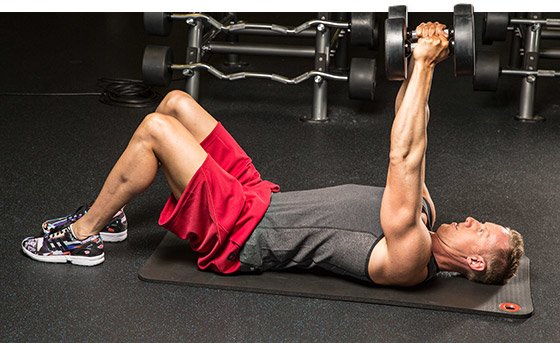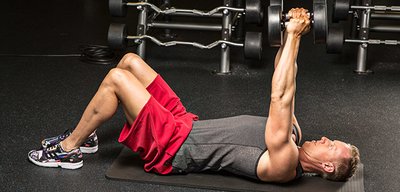The dumbbell floor press is an oft-forgotten exercise that should get a lot more love than it does. Or maybe everybody's doing it, but I just can't see them because they're down on the ground over next to the rack. But I kinda doubt it.
So why bother with this version of the press? I could go on for a while. For one, it's a great option when you're in a crowded gym and the benches are taken. It also doesn't have the same "How muchya" associations as the almighty barbell bench, so you can experiment with different variations without feeling self-conscious about using small(ish) weights. More importantly, it's a great alternative pressing variation for banged-up lifters who can't tolerate heavy barbell pressing week in and week out.
Need a final reason? It's harder to screw up than the barbell bench. If you're a bodybuilder who complains that you can't "feel" the bench press in, say, your chest or triceps, this will make you feel it. If you're an athlete who doesn't bench but wants to develop your core and shoulder stability while building overall strength, this will do it.
In short, the floor press is a tool you need to have in your arsenal. Now here's what you need to know.
What Makes The Floor Press Special?
Where to begin? For folks with shoulder issues, the dumbbell floor press is usually better tolerated than the traditional bench press because you're able to use a neutral grip, and pressing on the floor limits the range of motion slightly. This reduces extension at the shoulder joint while still providing a good training effect for the pecs and triceps.
Plenty of people who experience lower back pain with traditional bench presses—in other words, plenty of people, period—find that moving to the floor often helps tremendously by reducing lumbar extension that comes from excessive arching. You know those dudes who do their bench presses with their feet on the bench? It's sort of like that, only much more stable, and you don't look like a complete tool.

Dumbbell Floor Press
Finally, for people looking to work their triceps who get elbow pain from skullcrushers and other extension variations, the dumbbell floor press is a great workaround.
If all of this makes it sound easy, don't be fooled. A heavy—or not so heavy—floor press can force you to generate just as much full-body tension as the bench press. And when it starts to feel easy, it's far simpler—and safer—to make difficult again without having a spotter close at hand.
The Finer Points
So one dumbbell or two? Using two dumbbells allows you to (duh) move double the weight, but using just one dumbbell offers a couple of advantages. First, you can use your other hand to help get the weight in place.
Pressing one arm at a time also increases the core demands of the exercise substantially, as you have to brace to keep your torso steady. Expect to feel your core the next day after the first time you try these.
One-Arm Dumbbell Floor Press Watch The Video - 00:27
If you go with two dumbbells, the best way to get the dumbbells into position is to have a partner hand them to you. But if you're by yourself, start with the dumbbells positioned vertically on your thighs and then bend your legs and lie backwards, using the momentum to fling the dumbbells into place.
Dumbbell Floor Press Watch The Video - 00:27
So now you're down on the ground with your bell or bells. What now? Here are the basics:
Reps
Dumbbell floor presses work best in moderate to high rep ranges, more for logistical reasons that anything. Trying to hoist super heavy dumbbells into position is a royal pain in the you-know-what. Like other things in life, the hardest part can be getting it up.
Hands
Experiment with different hand positions to figure out what feels best to you, but in general, utilizing a neutral grip with be easier on the shoulder joint. This is what I recommend most of the time, so try it first.
Legs
You can press with your legs straight or bend your knees. Neither way is necessarily better, but each will change the dynamic of the exercise slightly. Pressing with straight legs increases the core demand because it eliminates your ability to use leg drive.
On the other hand, bending the knees may be a better option for folks with lower back pain. Try both and see what feels best.
Progressing The Floor Press
After you've done regular dumbbell floor presses for a while, you may reach a point where your progress starts to stall out, or you reach a strength level where you either max out the dumbbells at your gym or it just becomes too hard to get them into position.
This doesn't mean you have no choice other than heading back to barbells—which might not be an option if you've got jacked-up shoulders. Instead, try these more difficult variations, which decrease the stability or add isometric holds to allow you to get a great training effect with lighter loads.
One-Arm Dumbbell Floor Press w/ Leg Lift Watch The Video - 00:32
Perform a single-arm dumbbell floor press with your legs straight and raised slightly off the floor to increase the demand on the core. This may look like more of a core exercise than a press, but trust me, it's still a great upper-body strength builder.
Make sure to use a full range of motion on the press and try to keep your torso and legs as steady as possible for the duration of the set. These are much harder than they look, so start light!
Dumbbell Floor Press "Countdown" Watch The Video - 01:13
Perform five reps, followed by a five-second isometric hold in the bottom portion of the rep with the arms just off the floor. From there, go straight into four reps followed by a four-second hold, then three, then two, and finally one.
In all it comes out to 15 reps and 15 grueling seconds of isometric holds. To make it even harder, lower the last rep as slowly as possible. Beware: These burn!
Dumbbell Squeeze Press Iso-Hold Watch The Video - 01:03
This a great drill for people who struggle to feel their chest working with most bench pressing variations. It also works great as a finisher after your regular pressing workout.
Set up just as you would for a normal neutral-grip dumbbell press. The only difference: Squeeze the dumbbells together so that they're touching. From there, press the dumbbells 1-2 inches off your chest and hold that position for 30-60 seconds, making sure to keep the dumbbells pressed together the whole time.
Dumbbell Squeeze Press/Floor Press Combo Watch The Video - 00:46
This is a great mechanical dropset, where you transition from a harder version of a movement to an easier one. Start by performing dumbbell squeeze presses, and then transition directly to dumbbell floor presses when you fatigue. I like to do 5-6 reps of each exercise, but you can play around with the reps.
If that combo looks like another great finisher on a long push day, you're right. But it can be more than that. As I mentioned in "8 Moves For A Crazy-Strong Core," you can also cycle through all of these advanced variations one-by-one, making each one the centerpiece of your routine for a while until you feel like you've conquered it, then moving on to the next.
Now get down on the floor!

